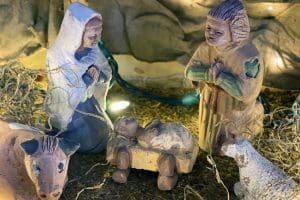![]()
Prodigies and Portents
By Daniel C. Peterson and William J. Hamblin
A few weeks ago, there was a brief sputter in the press about a newborn lamb in Palestine. Although the birth of lambs in that region generally goes unremarked by the international news media, this particular lamb seems to have had the Arabic name for God, Allah, written in its fur.
https://news.bbc.co.uk/2/hi/middle_east/3572325.stm
https://www.islamcan.com/miracles/palestinelamb.shtml
Few if any in the media recognized that this was simply the most recent example of one of the oldest religious beliefs in history, that God manifests his will through prodigies and portents. In modern English, the term prodigy tends to refer to someone displaying unusual talent, skill, or intelligence. The original Latin term, however, had a much more specifically religious meaning. Anciently, the Latin word prodigium referred to an unnatural event or manifestation, which, if properly interpreted, served as a sign or warning from the gods.
Both modern and ancient peoples agree that there is a natural order in the universe. Moderns generally see this order as based on natural law (whether divinely ordained or not is disputed). For moderns, seeming aberrations in nature are not, in fact, violations of natural law, but are merely, statistically speaking, extraordinarily rare manifestations of precisely the same natural laws that make the universe seem generally ordered and predictable. While unusual, they are not, in fact, abnormal.
Ancients, however, tended to view cosmic order as divinely established and maintained. It existed because the gods willed order to exist. Without constant divine support, cosmic order could dissolve into chaos. Unnatural phenomena-or prodigies-were thus viewed as marking not merely a statistically rare anomaly that was still part of natural law, but rather as a momentary divinely created cessation of cosmic order, whereby the gods were portending remarkable changes in the world. Prodigies were thus unnatural and abnormal, not just unusual, and were caused by the will of the gods.
There are a number of events which ancients viewed as prodigious: celestial phenomena such as comets; rare weather patterns, such as lightning striking the statue of a god or emperor; or the birth of unusual animals or peoples, such as conjoined twins. Prodigious births were frequently described as “monstrous” (Latin: monstrum), from the Latin moneo-“to bring to notice, show, or warn”-precisely because such births were viewed as acts of the gods, warning mankind of future events. The star of Bethlehem would have been viewed by most ancient people as a prodigy (Mt 2.1-12); likewise, aberrant astronomical phenomena prophesied as signs of the last days would be considered prodigious by ancient readers (Mt 24.6-8; Rev 6.12-14).
Jews clearly believed in prodigies. As the fall of Jerusalem to the Romans in AD 66-70 neared, Josephus reported many prodigies and portents (Greek teras) in the city, including a star resembling a sword, a comet, a light shining in the temple, a cow giving birth to a lamb at the moment it was to be sacrificed in the Jerusalem Temple, armies fighting in the sky, and a voice from the Holy of Holies declaring, “We are departing” (Josephus, Jewish Wars, 6.288-315). Unfortunately, the Jewish temple priests misinterpreted the star and shining light as good rather than evil omens, and failed to act on the prodigious messages from God.
Obscure Meanings
Which was precisely the problem with ancient prodigies. Precisely what a prodigious event might portend was often quite obscure, creating the need for interpretation of prodigies. The Babylonian priestly order of the baru had a huge library of clay tablets detailing astronomical phenomena and the interpretation of the entrails of sacrificial victims. Greeks had professional seers bearing the title of mantis, who would interpret omens and portents. The Romans likewise had specially trained priestly orders such as augures and haruspices, who would study and interpret prodigies.
Such signs would be sought, observed, examined, and interpreted through a library of divination manuals kept in temples. These Roman practices are still reflected in English words such as inaugurate-to have the augurs declare a good beginning-and auspicious, from avis specio, “bird watching” for good portents. Studying the livers and other viscera of sacrificed animals for prodigious abnormalities was widespread throughout the Middle East and the Roman world. Archaeologists have discovered a Babylonian clay model of a liver used for such interpretations.
https://www.bible-history.com/babylonia/BabyloniaClay_Model_of_a_Sheeps_Liver.htm
Likewise, an Etruscan bronze model of a liver used for interpreting sacrifices was found in the late nineteenth century in Piacenza, Italy.
https://users.tpg.com.au/etr/etrusk/po/liver.html
Although belief in prodigies has waned in the modern world, they can still be found in many thinly veiled ways. Like the Palestinian Muslim shepherd with his prodigious lamb, some modern Christians and Jews have seen a recent prodigy in the curious case of the Red Heifer. Numbers chapter 19 records the necessity of using the ashes from a pure red sacrificed heifer in a ritual to purify priests before they can serve in the Temple. Many eschatological Christian and Jewish groups believe that the Jews should build a third temple in Jerusalem, but have long wondered how new priests could be properly consecrated without the ashes of a red heifer. Recently, the prodigious births of pure red heifers in both Texas and Israel has been seen by many as a sign from God that it is now time to rebuild the Temple.
https://www.templeinstitute.org/current-events/RedHeifer/index.html
https://www.hope-of-israel.org/redh.htm
https://www.endtimeinfo.net/Temple/redheifer.php
(Randall Price, The Coming Last Days Temple (Harvest, 1999), pp. 361-378, has a discussion from an Evangelical perspective.)
Remarkably, the belief that God manifests his will through prodigies has survived five thousand years of momentous religious transformation-including the conversion of the peoples of Palestine from Canaanite paganism to Judaism, Hellenistic polytheism, Christianity, and finally Islam-long enough to bring international attention, briefly at least, to an obscure Palestinian shepherd’s newborn lamb.

















